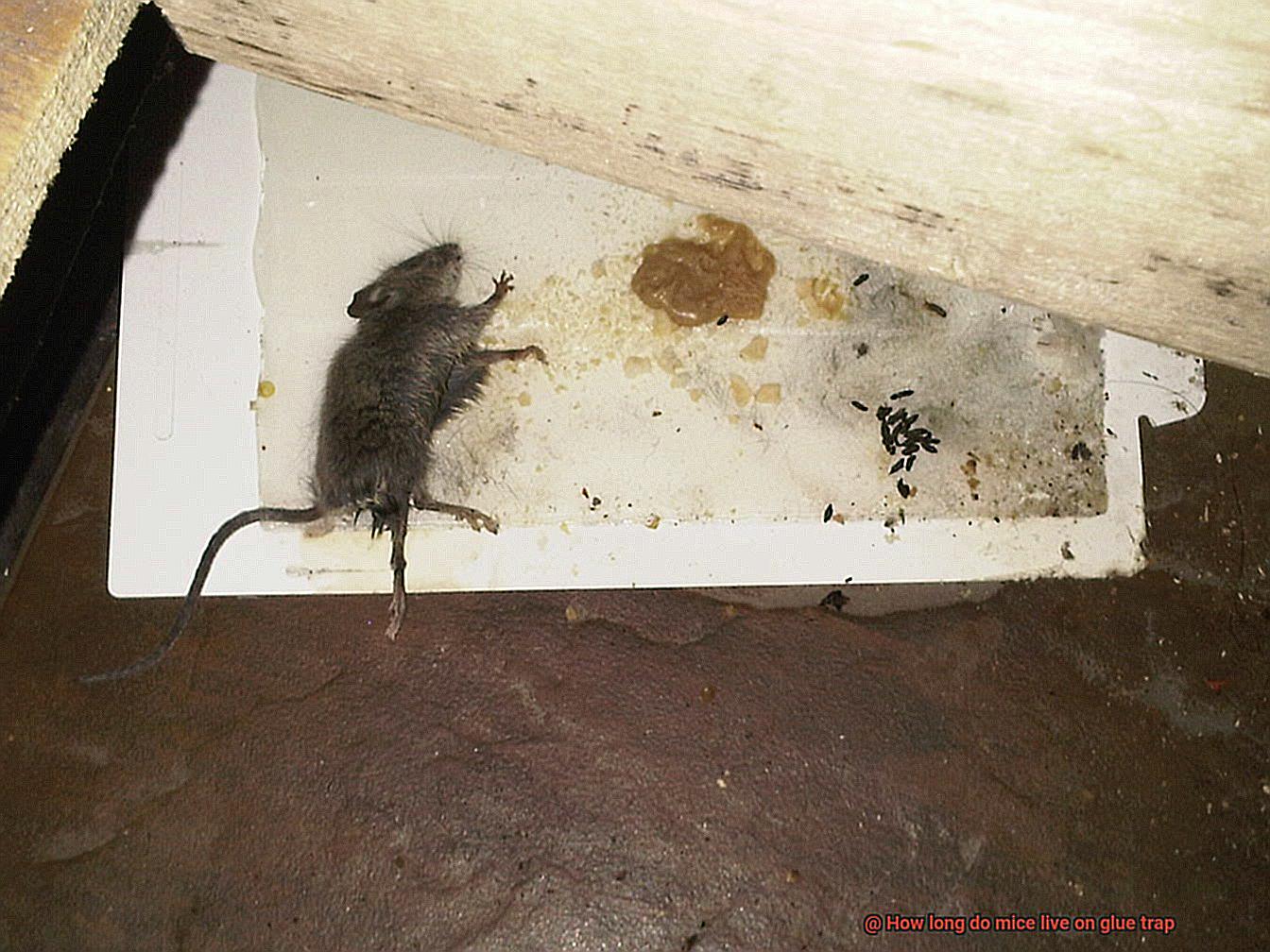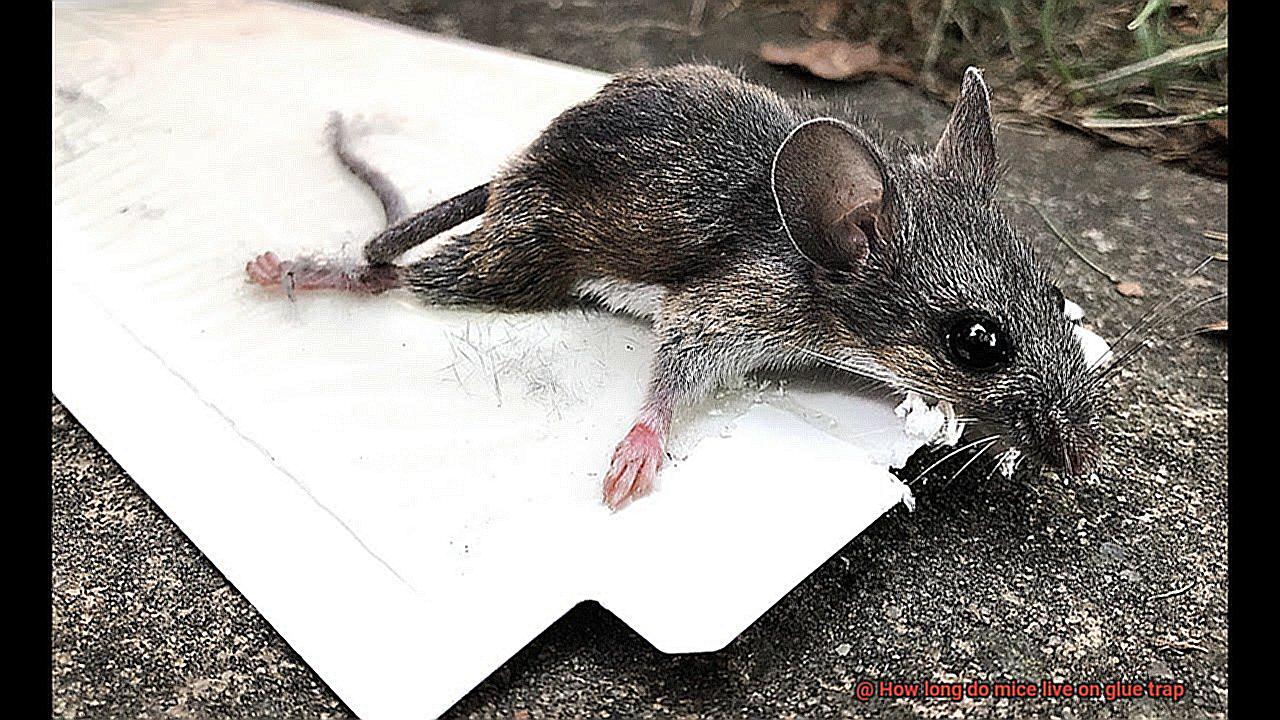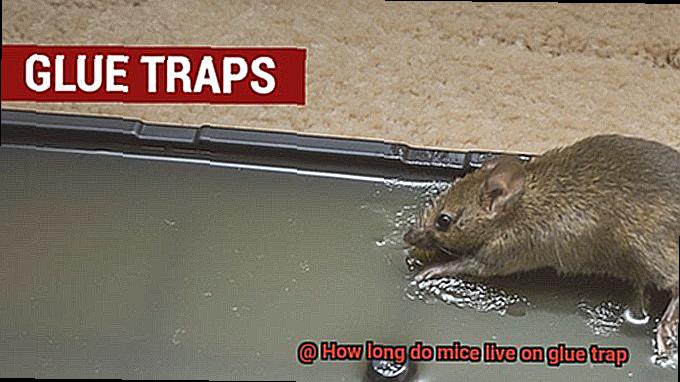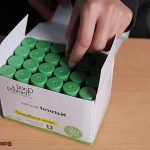The eternal battle between man and mouse. When it comes to dealing with these sneaky critters, glue traps have become the go-to solution. They promise swift capture, easy disposal, and a sense of victory over our tiny foes. But what happens to those trapped mice? How long do they endure their sticky nightmare?
Well, my curious friends, you’ve stumbled upon the right article. Here, we’ll unravel the gripping tale of mice entangled on glue traps and shed light on their survival rate according to science.
But before we dive into the nitty-gritty details, let’s take a moment to explore the emotional side of things. Using glue traps raises ethical questions and stirs up mixed feelings. By understanding the bigger picture surrounding rodent control methods, we can make more informed choices that align with our values.
So buckle up, folks. We’re about to embark on a journey that will leave you amazed at what these little creatures endure while caught in their sticky prison.
Glue Traps
Contents
- 1 Glue Traps
- 2 How Long Can Mice Survive on Glue Trap?
- 3 Factors Affecting Survival Time
- 4 The Stress and Exhaustion of Being Trapped
- 5 Death by Dehydration or Starvation
- 6 Inhumane Nature of Glue Traps
- 7 Variation in Survival Times
- 8 Age and Health as Factors in Survival Time
- 9 Possibility of Escape from Glue Traps
- 10 Conclusion
When it comes to pest control, one popular option is the use of glue traps. In this article, we will delve into the definition of glue traps, explore their effectiveness, discuss ethical concerns, and consider alternative approaches for rodent control.
Defining Glue Traps:
Glue traps, also referred to as sticky traps or adhesive traps, are ingenious devices designed to catch and immobilize small animals, particularly mice and other rodents. These traps feature a flat surface or board coated with a potent adhesive substance that renders any creature that touches it unable to move or free itself.
Construction and Placement:
Glue traps are typically made from non-toxic materials such as cardboard or plastic, ensuring their safety for use in indoor environments. The adhesive used on these traps is highly sticky and viscous, making it incredibly challenging for trapped animals to escape its grip.
To maximize their effectiveness, these traps can be pre-baited with food or scented attractants, luring unsuspecting rodents onto the sticky surface.
Effectiveness and Ethical Concerns:
While glue traps serve their purpose by capturing rodents efficiently, there have been legitimate ethical concerns regarding animal welfare. The immobilization caused by the adhesive can lead to prolonged suffering for trapped animals.
It is distressing to imagine them struggling for hours or even days before eventually succumbing to exhaustion, dehydration, or injuries sustained from futile attempts to escape.
Alternative Approaches:
To address these ethical concerns, some manufacturers have developed “live catch” glue traps that aim to capture rodents without causing harm. These traps feature a shallow layer of adhesive that allows animals to walk on it without becoming completely stuck.
However, it is important to note that these alternatives may not be as effective as traditional sticky traps.
How Long Can Mice Survive on Glue Trap?
Glue traps, those sticky boards designed to catch mice and other rodents, have long been a popular choice for rodent control. However, have you ever wondered just how long these poor mice can survive on these sticky traps?

Let’s dive into the nitty-gritty details and unveil the truth.
The Effects of Glue Traps on Mice:
Being trapped on a glue trap is no picnic for mice. The sticky adhesive can cause distress and panic, leading them to struggle even harder to escape.
Unfortunately, the more they struggle, the more entangled they become, making it increasingly difficult to break free.
Factors Affecting Survival Time:
Several factors influence how long a mouse can survive on a glue trap. Let’s explore these factors:
- Temperature: Warmer temperatures can accelerate dehydration and exhaustion in trapped mice, potentially shortening their survival time. Imagine being stuck on a hot glue trap with no way to quench your thirst.
- Size and Age: Smaller and younger mice may have less body mass and energy reserves, which can decrease their chances of survival. These tiny creatures simply lack the physical stamina needed to endure the stress of being stuck.
- Health and Condition: Mice that are already weakened or suffering from illnesses may have a shorter survival time on glue traps. Their compromised immune systems make it harder for them to fight off dehydration and other detrimental effects.
Average Survival Time:
While there is no exact timeframe, experts estimate that mice typically survive on glue traps for several hours to a few days. However, it’s important to note that this duration can vary due to factors such as temperature, mouse size, age, and health.
Prolonged Suffering and Ethical Considerations:
The prolonged suffering experienced by mice stuck on glue traps raises ethical concerns. Extended struggling can lead to exhaustion, dehydration, and even starvation. As a result, many animal welfare organizations and experts consider glue traps to be inhumane.
Alternatives to Glue Traps:
Thankfully, there are alternative methods of rodent control that are considered more humane. Live traps provide a way to catch mice without causing harm, allowing for their safe release in a different location.
Electronic traps offer a quick and painless way to eliminate rodents. Additionally, preventive measures such as sealing entry points and maintaining cleanliness can help deter mice from entering your space.
Factors Affecting Survival Time
Glue traps, a controversial method of rodent control, hold captive mice in a sticky grip. Understanding the factors that affect their survival time is crucial to shed light on this contentious issue. In this blog post, we will delve into the various elements that influence how long a trapped mouse can endure on a glue trap. By exploring topics such as size and age, trap placement and accessibility, environmental conditions, injuries and stress, and predation, we aim to unravel the secrets behind the survival time of these unfortunate creatures.
- Size and Age: The mighty power of the mouse’s size and age can make or break its chances of survival in the glue trap realm. Smaller and younger mice possess a remarkable advantage – they are agile and nimble, allowing them to maneuver themselves out of the adhesive’s clutches more effortlessly compared to their larger, older counterparts.
- Trap Placement and Accessibility: The strategic positioning of glue traps plays an influential role in determining a mouse’s survival time. Placing traps near abundant food sources increases their chances of discovering sustenance, thus extending their survival. Conversely, traps located in isolated areas devoid of access to nourishment or hydration lead to shortened survival times for these trapped creatures.
- Environmental Conditions: The environment surrounding the trapped mouse harbors great power over its fate. Temperature, humidity, and ventilation all wield an elemental force. Warmer temperatures hasten the cruel grasp of dehydration, leaving trapped mice with limited time. High humidity levels intensify the stickiness of the glue, exacerbating respiratory distress for these unfortunate captives.
- Injuries and Stress: The struggle for freedom often takes its toll on mice caught in glue traps, resulting in physical injuries that deepen their plight. Broken bones and torn muscles cripple their chances of survival. Moreover, the stress induced by their entrapment weakens their immune system, rendering them more susceptible to illness and infection.
- Predation: The presence of predators in the vicinity adds an ominous twist to the survival time of trapped mice. Stealthy hunters such as cats or snakes lurk nearby, ready to pounce on these helpless captives. The looming threat of predation leads to swift demises, leaving no chance for escape.
The Stress and Exhaustion of Being Trapped
Imagine being trapped on a glue trap, your every movement met with resistance, as if the world has conspired against you. This nightmare becomes a harsh reality for mice unfortunate enough to find themselves in this sticky predicament.

The glue, like a merciless captor, binds them tightly, making escape seem impossible. As they struggle to break free, their tiny bodies become more entangled in the vicious grip of the glue, inflicting physical and emotional torment that takes a toll on their well-being.
Physical exhaustion ensues as trapped mice expend every ounce of energy in futile attempts to liberate themselves. Pushing, pulling, and twisting their fragile bodies, they fight against the unyielding force of the glue. But with each struggle, their exhaustion deepens, their strength waning with every failed attempt.
Emotional fatigue grips them tightly as stress levels skyrocket. Trapped mice are besieged by fear and anxiety, knowing they are powerless to escape their impending doom. The relentless dread of their situation hangs heavy in the air, suffocating their spirit.
Denied access to food and water, these trapped mice find themselves deprived of basic survival needs. Their already exhausted bodies lack the strength to scavenge for sustenance, intensifying their stress and exhaustion. It’s a cruel cycle that amplifies their suffering.
Frantic attempts to break free can lead to injuries that compound their misery. Bones break, skin tears as they thrash about in a desperate frenzy. The physical toll of these wounds adds an additional layer of pain and exhaustion to their dire circumstances.
With each passing hour, desperation escalates for trapped mice. Hope dwindles like a dying flame, survival becoming an ever-elusive dream that slips further from their grasp.
Tragically, if not released or rescued in time, mice succumb to the stress and exhaustion of their glue trap prison. Their tiny bodies, delicate and frail, are not built to withstand the relentless strain indefinitely.
Death by Dehydration or Starvation
Glue traps, often used to catch mice and small rodents, subject these trapped creatures to a cruel fate: death by dehydration or starvation. Once ensnared, the mouse becomes immobilized, unable to escape the sticky surface. What follows is a slow and agonizing demise.
Mice possess high metabolic rates, necessitating a regular intake of food and water for survival. Unfortunately, when trapped on a glue trap, access to these essential resources is cut off. As they struggle against the adhesive surface, desperate attempts to free themselves lead to a significant expenditure of energy.
Dehydration swiftly sets in as the mouse’s body loses water through respiration and evaporation. Denied access to water, their bodily functions falter and organ failure becomes inevitable. It’s a harrowing process, drawn-out and filled with suffering.
Simultaneously, starvation becomes a pressing concern. Mice require small amounts of food throughout the day to meet their dietary needs. Trapped on the glue trap, they are unable to consume any sustenance. Their bodies resort to breaking down muscle tissue for energy, resulting in malnutrition and an eventual demise.
The time it takes for a mouse to succumb depends on various factors: temperature, humidity levels, overall health, and size. Under optimal conditions, it can take anywhere from several hours to a few days before death claims the trapped mouse.
It’s crucial to recognize that death by dehydration or starvation is far from instantaneous or painless for these unfortunate creatures. The suffering experienced is protracted and distressing. This raises ethical concerns regarding the use of glue traps as a means of rodent control.
Advocates argue for more humane alternatives, such as live traps or other methods that allow for the safe capture and release of mice. By choosing compassion over cruelty in our approach to pest control challenges, we ensure that all living beings are treated with respect.
Inhumane Nature of Glue Traps
Glue traps, those seemingly innocent adhesive boards used to catch mice, hide a dark and inhumane side that often goes unnoticed. The design of these traps is what makes them particularly cruel. Imagine a small mouse innocently scurrying across the floor, only to find itself stuck on a surface it cannot escape from. The sticky adhesive immobilizes the mouse upon contact, trapping it in a desperate struggle for freedom. The fear and distress experienced by these helpless creatures are unimaginable.
But the suffering doesn’t end there. As mice desperately try to break free from the glue trap, they often end up injuring themselves in the process. Torn fur, broken bones, and even self-amputation are not uncommon outcomes of their frantic attempts to escape. These innocent creatures suffer both physically and psychologically, unable to move or find shelter. Their distress is heart-wrenching.
And here’s where it gets even worse. Mice trapped on glue boards can remain immobile for hours or even days. They are stuck in one spot without access to food or water. Starvation, dehydration, and exhaustion become inevitable outcomes for these helpless creatures. A study conducted by the Humane Society of the United States found that mice caught on glue traps can suffer for more than 24 hours before eventually succumbing to death from dehydration or exhaustion.
If that isn’t enough to convince you of the cruelty of glue traps, consider the unintended victims they ensnare. Non-target animals such as pets or wildlife can accidentally come into contact with these traps and get stuck themselves, leading to similar consequences of suffering and potential death.
Animal welfare organizations and advocates widely criticize the use of glue traps for these reasons. There are plenty of more humane alternatives available, such as catch-and-release traps, electronic traps, and integrated pest management strategies that focus on prevention rather than extermination.
Variation in Survival Times
Imagine a delicate mouse innocently scurrying across the floor, unaware of the treacherous trap lying in wait. Suddenly, its dainty paws make contact with the sinister adhesive surface, and a harrowing battle for survival commences. But why do some mice manage to break free while others remain ensnared for hours or even days? In this article, we delve into the multifaceted factors that influence a mouse’s survival time on a glue trap.
Size Matters:
When it comes to glue traps, size plays a pivotal role. Smaller mice face a grim fate, as the expansive adhesive surface area swiftly immobilizes and suffocates them, leaving little hope for escape.
Health Status:
The health of the mouse also significantly impacts its survival time on a glue trap. Weakened or sick mice are more prone to succumbing swiftly to the stress and trauma of entrapment compared to their healthier counterparts.
Glue Type and Strength:
Not all glues are created equal. Some adhesives are meticulously crafted to be highly sticky and ruthlessly effective at ensnaring mice, while others may possess less adhesive strength or slower drying times. The tenacity of the glue serves as a formidable barrier, heightening the difficulty of escape for trapped mice.
Environmental Conditions:
The environment in which the glue trap is deployed can profoundly affect survival times. Warmer temperatures accelerate dehydration and exhaustion, leading to abbreviated survival times.
High humidity levels compromise the adhesive properties of the glue, potentially diminishing its effectiveness in capturing mice.
Additional Factors:

Survival times on glue traps exhibit significant variability due to an array of additional factors. The intensity of the mouse’s struggle to free itself, the presence or absence of sustenance and hydration nearby, and external interventions such as human interference or exposure to predators all exert influence over the duration of survival once ensnared.
Addressing the ethical concerns associated with glue traps is paramount. These inhumane devices inflict untold suffering, subjecting trapped animals to a protracted and agonizing demise.
Animal rights organizations vehemently condemn their use, advocating for alternative and compassionate approaches to rodent control.
Age and Health as Factors in Survival Time
Age and health are crucial determinants of survival time for mice caught on glue traps. Younger mice, with their nimble bodies and peak physical condition, have a better chance of escaping the adhesive grip of the trap.
As they grow older, their agility decreases, making it increasingly challenging for them to break free. However, age is not the sole factor at play here. The overall health of the mouse is equally important. Mice weakened by illness or malnutrition are more likely to succumb quickly to the trap.
Imagine trying to wriggle free from a sticky mess when you’re already feeling under the weather – not an easy task, right?
But it gets even trickier. Mice with pre-existing injuries or disabilities face an uphill battle when it comes to survival. Their limited mobility hampers their ability to struggle effectively, leaving them vulnerable and unable to escape. And let’s not forget the stress factor.
Being trapped on a glue trap is undoubtedly stressful for our tiny rodent pals. This stress can increase their heart rate and lead to respiratory distress, ultimately accelerating their demise.
Even healthy adult mice have a tough time surviving on a glue trap. The adhesive substance used is highly effective at immobilizing rodents, regardless of their age or health. So what happens if a mouse remains trapped for an extended period? Exhaustion sets in. The longer they’re stuck, the more exhausted they become. This exhaustion can lead to severe dehydration and starvation, further diminishing their chances of survival.
In light of these findings, it’s crucial for those using glue traps to consider the suffering experienced by trapped mice. Regularly monitoring the traps and taking immediate action to release or humanely euthanize trapped mice can help prevent prolonged suffering.
Possibility of Escape from Glue Traps
Glue traps, those sticky contraptions designed to catch mice and pests, are a common sight in many households. But have you ever wondered if those little critters can actually escape from these seemingly impenetrable traps? Well, the answer is both yes and no. Let’s delve into the intriguing world of glue traps and explore the possibilities of a mouse’s great escape.
Size Matters:
When it comes to glue trap entrapment, size matters just like in the animal kingdom. Smaller mice have a better chance of wriggling free due to their agility and size advantage. It’s like trying to squeeze through a tight spot – the smaller you are, the easier it gets.
Trap Condition:
The condition of the glue trap plays a significant role in whether a mouse can make a break for it. If the adhesive has lost its stickiness or there are gaps in the trap, it becomes easier for our furry friends to break free. So, maintaining trap integrity is crucial for its effectiveness.
Partial Sticking:
Sometimes, luck is on the mouse’s side. If only a part of its body gets stuck on the trap, it may resort to extreme measures to escape – tearing off its trapped body parts. However, this desperate act can lead to severe injuries or even death, so it’s not an ideal scenario.
Limited Space:
A cluttered environment or limited space around the trap can be a deterrent for mice trying to escape. Obstacles can hinder their movements and prevent them from breaking free from the gluey mess. So, keeping the area clear around the trap is essential.
Duration of Entrapment:
The longer a mouse remains stuck on a glue trap, the weaker and more exhausted it becomes. As you can imagine, this reduces its chances of survival and escape. Time is not on their side, so it’s crucial to act swiftly if you encounter a trapped mouse.
MGbH2dzR1Y0″ >
Conclusion
Mice, unfortunately, do not fare well when caught in glue traps. These sticky contraptions may seem like a convenient solution for rodent control, but they can lead to a slow and agonizing death for the trapped mice. Once stuck, the mice struggle desperately to free themselves, often injuring themselves in the process. With no means of escape or access to food and water, their chances of survival are grim.
The exact duration that mice can live on a glue trap varies depending on several factors such as the size and health of the mouse, environmental conditions, and available resources. However, it is safe to say that their suffering can last anywhere from hours to days.
Imagine being immobilized on a sticky surface with no hope of escape. Every movement you make only intensifies your entrapment, causing excruciating pain as your fur gets matted and your limbs become increasingly tangled. The panic sets in as hunger gnaws at your insides and thirst parches your throat. It’s a horrifying reality for any creature unfortunate enough to be ensnared by these adhesive traps.
In addition to the physical torment, glue traps also pose risks to humans and other animals in the vicinity. If not handled properly, there is a chance of inadvertently releasing a live mouse or coming into contact with its bodily fluids, which can carry diseases.
It’s important to recognize that there are more humane alternatives available for dealing with mouse infestations. Instead of resorting to glue traps that cause immense suffering, consider using snap traps or live-catch traps that allow for safe removal and relocation of captured mice.
In conclusion, while glue traps may appear effective at first glance, they subject mice to an unimaginable ordeal.






